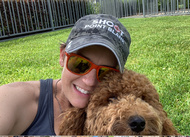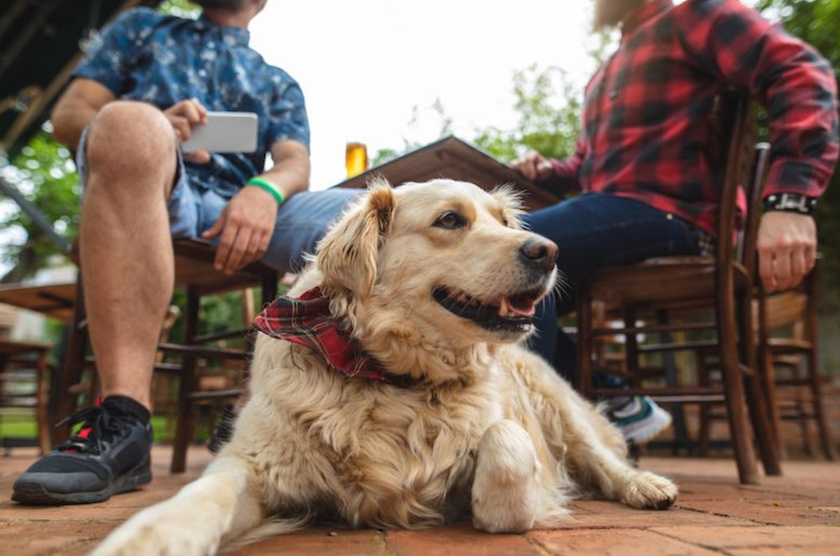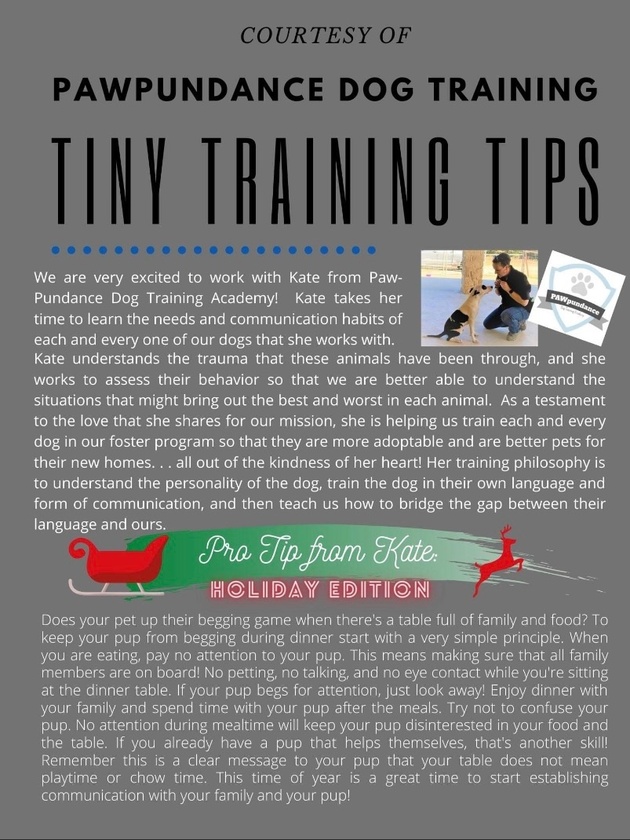
It’s ok! We’re here to help. We speak a little dog and can help translate for both of you. It’s probably just a miscommunication! And we are here to help get you both speaking the same language! Woof!
Connect with the PAWpundance training team and other members of the dog community to discuss better ways to communicate with your furry house guest.
**To get started USE code: TRIAL1month **
Training two dogs - of different skill level at the same time. OMG!! Patience and I mean the older pup with more training needs to have it. haha.
In this case, Buckee was way more patient. When I go meet new clients - I get these situations all the time. And I never tell them, "well it's going to be this for that dog and more for the other dog... yada yada." We are all about not nickel and diming our clients.
So right off the bat, our structure was like this: packages only. One price.
We meet with the prospective client. We have three tiers of the level of training that the wish to work toward. We observe the pup(s) and give feedback on what we think which package best fits. Basically: We assess where the pups are. We discuss where the clients would like to go (training toward and not away, positive training vs. punishment) then we choose a path. We then discuss what their expectations are. We create an evaluation that matches their expectations with level of training they would like to commit to as a team.
Then there is one cost and it is paid upfront. It covers everything. Leashes, Treats, any staff I need to hire etc. I have already calculated it. Then we embark on the journey as a team with the same goal, to train the pups. We all have skin in the game and we all want to see a successful completion of the evaluation.
If the pup is struggling to get there, it is my job to put more resources toward making it happen. More time, treats, knowledge. The only time we have an issue is if the client is literally blocking my efforts and not allowing me to do this - and it's happened. We then work with the client more to educate them on the process. But more resources to helping them understand the reevaluate. Most of the time the clients don't block us. The packages cost enough that the clients are motivated.
We also do not do short packages. We don't do anything less than a month. We want to be sure that the training will have a lasting effect not just with the dog but with the client. We are not just working with the pup but we're also coaching the client. So it's two jobs. A short, easy job is 4 weeks, most are closer to 4 months. For that length of time, our training will be in the ball park of 5-figures. And it's not overpriced. It's just a big number up front.
Imagine you went every 6 weeks to get your haircut. If your hairdresser had a policy where you paid once/year for hair cuts then enjoyed not paying for the rest of the year - it sounds kind of nice but that number would be pretty big up front. So 8 haircuts per year (52 divided by 6 is about 8) and $100/cut. ($80 cut +$20 tip included). So you would write your hairdresser a check for $800. Then get a punchcard for 8 cuts of hassle-free haircuts, walk-in, walk-out, on the books - haircuts. It would seem like a big number up front, but on the back end, it sounds kind of convenient. To be able to just walk in like a scene from "The Good Fellas" get your hair cut and then when it's done - just walk out. And the contract between you and the hairdresser isn't one cut, it's 8. So the bar for customer service would raise. They would try to keep you happy for a whole year. Not just one cut.
Why are other businesses not trying this? It's really difficult to provide such a high level of customer service. We realized that hiring staff to meet this expectation was impossible when we could only compete with Target for pay grades. We had to find true believers in what we were doing with the pups in order to continue to "do the right thing".
So... It's a crazy business model... I'm still working on how to make it grow and not just kill my body. As Naval says, I can't sell my time. But I'm torn, at some point - I do need to show up and help teach.
So back to team teaching. We always kept the family together. Trying to teach one without the other is just silly. You can maybe break something down with one independently but you'll still have to bring them back together to get them on the same page eventually (the reason some of these dog camps don't work. Eventually they come home and the real work has to begin.) It was once thought that dogs were not good at the "monkey see, monkey do" behavior. But more recently, we have learned that dogs learn a lot from their littermates which means... monkey see, monkey do.
So what does that mean?
Cat's don't train as easily as dogs. Their motivations aren't understood the same. However, as the story goes, if you want to train a cat... train the dog - with something the cat wants. The cat will start mimicking the dog in order to get the thing they want but the dog is receiving.
We used to think that dogs couldn't do this since cats were soooooooo good at it. But now we realize, dogs just do it in their own way. Dogs learn from the dogs around them when they are pups in a pack. And Bailey was no exception.
Shaping is a term that trainers like to throw around and I'm no exception. :-) It simply means breaking a behavior down into small teachable steps until the entire skill is a complete step. Teaching a "down" is a great example. We start in a sit and begin pulling the nose forward. click. Then we reset. Nose forward and a paw inches forward. click. Reset. Then Nose, Step, step. Click. Reset. Nose, Step, Step, and chest on the ground. Click!! Jackpot!! Then reset - put it all together. Motion to the ground, Nose-paw-paw-chest-click!! Yes!! Reset! Point to the ground. Paws slide out-chest to the ground and click!! We have a down. Eventually it becomes a very fluid gesture that began just pulling the nose forward.
But not all dogs will get it that simply... some dogs will constantly stand. So there are other ways to train these skills. This is just one way to train a down. It's just a method. There are different ways to do it Karen Pryor says there are 8 categories... 4 are positive. We stay in this realm.
When we are teaching a new skill, if your pup is confused about what he should be doing - if he keeps standing - team training IS something you can try if you have a good boy like Buckee available. Keep in mind. It is a fragile method. It's best if your pup is in that category where he just keeps standing and won't go down. This is helpful to remind you to keep trying different things. And when you get stuck, reach out to a community of people. Especially if you have positive trainers that have tried lots of different ideas. You never know which idea might break the ice and get you on your way. Then you can go drill on another tried and true method if you want. But read and ask questions. Remember - this was considered useless by all the esteemed animal behavioralist until just recently because dogs weren't behaving like cats... so make up your own mind. And ask lots of people.
Remember - What can two trainers always agree on? That the third trainer is doing it wrong. hahaha. So Keep up the good work!! And ask questions!! The PAWpundance Community is here to help!!
Welcome to PAWpundance Dog Training Academy on Locals.com!
We’re thrilled that you’ve joined our community! PAWpundance is a place for positive, dog-loving people to come together, share experiences, and help each other grow. Locals offers an “ad-free experience,” so even a small contribution helps support our tech and keeps our community thriving.
We want to see your furbabies!
We’re here to assist with any questions you may have about training, behavior, and more. At PAWpundance, we believe in blending knowledge with a bit of fun—expect plenty of paws, puns, and maybe even a dance or two! Together, let’s enjoy some laughs and build stronger relationships with our pups.
Our Philosophy:
We’ve invited another species to live in our homes, and our dogs are much more than accessories; they’re our guests. They don’t speak our language, and like in the movie E.T., we don’t want to be the intimidating figures trying to coerce a scared, confused being. Instead, we want to be like ...
Eye Contact, Eye Contact, Eye Contact!
Reward every glance. Start by reinforcing brief glances, then encourage your pup to hold your gaze a bit longer. Gradually phase out your part of the eye contact—your pup will learn to watch you and adapt to your movements naturally. This approach helps them learn to walk with you without relying on leash cues.
Remember, the leash is purely for safety—not for communication.
Take a look at this video with Meghan and Buckee. Buckee is watching Meghan closely, and she rewards him by making eye contact, smiling, and offering treats. Meghan also looks forward occasionally, teaching Buckee to walk with her in sync.
Notice that Buckee is a reactive pup, so the leash is essential for safety, especially if he responds to something unexpectedly. However, it’s only used for physical control when necessary. When Buckee refocuses, Meghan reestablishes instructional control, and they continue their walk together. She does a fantastic job of engaging with him! In ...
Loose-Leash Walking Tip:
Where you reward makes a big difference! Try using the hand on the same side as your dog when giving treats or praise.
When you reach across your body to reward with the opposite hand, it draws your dog’s nose in front of you, encouraging them to move ahead and potentially start pulling.
In the video of Meghan and Domino, Meghan holds the leash with her left hand while Domino walks on her right. She rewards him by petting and giving treats with her right hand. This keeps Domino walking by her side on a loose leash, rather than in front, pulling her along.
Next time you’re out walking with your pup, try rewarding with the hand on the same side as your dog.
https://twitter.com/wholedogjournal/status/1295508215740932098?s=21
How to teach you pup to be a good dining companion! What a great skill!

https://twitter.com/wholedogjournal/status/1292609106637987840?s=21
This is about counter-surfers, but I love the description of trying to shame dogs. This author, Pat Miller helped me understand this concept in her book the Power of Positive Dog Training.
If you’re still on Twitter, the Whole Dog Journal is a great group to follow. Lots of fantastic info!













